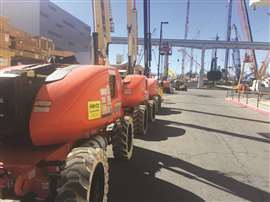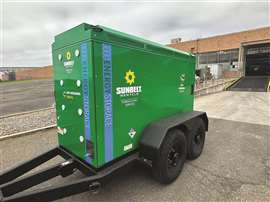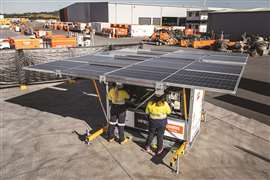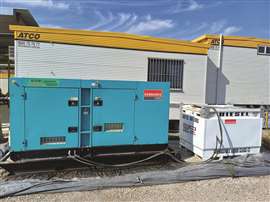What will 2025 hold for equipment rental companies?
05 February 2025
With sentiment for 2024 pointing towards an industry waiting for better times, what is the outlook for 2025?
 Photo: KeetaKawee via AdobeStock
Photo: KeetaKawee via AdobeStock
As the equipment rental industry enters 2025, companies are preparing for another year of growth—one that will also bring new challenges and emerging trends.
But what are those challenges, and how will companies look to overcome them?
Will changes to customer behaviour drive the energy transition? Will technological advancements streamline the rental process? Will economic uncertainties ease and allow for further growth?
IRN spoke with industry experts to understand their expectations for the year ahead.
Rental market trends
Looking at North America, equipment rental firms are expected to see slower growth in rental revenues in the next few years as the markets in the United States and Canada continue to soften.
Research from the Canadian Rental Association (CRA) states that Canada will enjoy moderate growth in the coming years due to rising demand from the non-residential construction sector.
Just last year the CRA predicted Canada’s equipment rental revenue to increase by 7.6% to $8.2 billion (€7.7 billion) in 2024, but the year-on-year growth rate will ease to 6.8% in 2025.
 Equipment rental in the US and Canada is expected to see moderate growth in the coming years.
Equipment rental in the US and Canada is expected to see moderate growth in the coming years.
“The outlook for Canada’s equipment rental industry reflects a balanced growth trajectory that will benefit from continued strength in the construction and industrial sectors,” said Melanie Misener, executive director of the CRA.
“As Canada’s economy stabilises, we expect steady demand across residential and non-residential investment, further fueling growth in equipment rentals.”
As for the US, economic figures also reveal that the growth of the rental sector in 2025 would probably come from the residential construction sector instead of the non-residential one.
The American Rental Association (ARA) expects equipment rental revenue to increase 5.7% year-on-year in 2025.
The ARA said the construction and industrial sectors are expected to see the lowest growth in the coming years while general tool hire will remain stable.
It said the rental revenue growth rate in the construction and industrial sectors is expected to ease from 7.9% in 2024 to 3.6% in 2025.
At the same time, Oxford Economics has said that a combination of fiscal stimulus, curbed immigration, increased tariffs and other policy decisions are likely to impact construction under US President Trump.
Its economists forecast that US fiscal expansion in the form of tax cuts, interest rate cuts, and higher federal spending in areas like defence would likely support privately funded construction activity in the near term.
Oxford Economics expects fewer rate cuts in 2026 amid higher debt and inflation expectations. It warned that higher rates could spill into other economies and, over the longer term, weigh on investment and construction activity.
How will rental companies tackle the energy transition?
 Jon Overman, CEO, HSS: The Hire Service Company.
Jon Overman, CEO, HSS: The Hire Service Company.
In the UK, market maturity and competition are key considerations. Jon Overman, CEO at HSS Hire, highlights how the industry will need to focus on efficiency and customer service; “The UK rental market remains one of the most mature in the world, and with that longevity comes a wealth of established hire companies.
“A highly competitive market coupled with a weaker economy means we are all going to need to be on our ‘A’ game with customers.”
Supporting that customer focus, Overman believes large UK rental companies will increasingly partner with builders’ merchants to offer a more complete service; “We’re already doing this and have been for quite a few years, proudly partnering with more than 20 different builders’ merchants around the UK.”
At the same time, he says cost efficiency remains a priority. “With the economy as it is—and in the wake of recent government policy changes on NMW and NI—being efficient in our operating models and cost structures will be important for the whole industry throughout 2025,” he adds. While economic trends shape rental revenues, another pressing issue for rental firms is the shift towards sustainable equipment.
According to Mark Keily, Health, Safety & Sustainability director at Sunbelt Rentals, the company is expecting customer behaviour to continue to evolve in 2025, with a growing focus on sustainable practices and alternative power solutions.
He says, “While there’s still work to be done in raising awareness about the operational benefits of sustainable equipment, we expect 2025 to be a turning point as more customers explore greener options and trial more sustainable solutions. This shift will likely include a greater adoption of renewable fuels.”
 A Sunbelt battery energy storage system (BESS). Photo: Sunbelt
A Sunbelt battery energy storage system (BESS). Photo: Sunbelt
Of course, the energy transition has been a key point of discussion for Sunbelt in recent years, as was referenced in its Sunbelt 4.0 plan.
With the plan, Sunbelt aims to make its sustainability initiatives a boon to its bottom line by using it to place more emphasis on customers.
The company has previously stated that it is ahead when it comes to sustainability initiatives, and is on track to exceed targets laid out in its Sunbelt 3.0 plan.
Moving forward, it has set new targets for Scope 1 and 2 to be 50% by 2034 from the 2024 baseline.
Keily elaborates on the company’s sustainability plans, “Sustainability and the energy transition have been key in shaping our strategy for the upcoming year. As part of our 4.0 growth strategy, we’ve been investing in sustainable equipment for many years and remain committed to continuing this.
“While we recognise that challenges remain in the industry around the adoption of greener and more sustainable equipment, we’re actively working to address these by focusing on practical and actionable solutions for our customers, suppliers and partners.
He adds that it includes providing education around sustainable solutions at its Green and Innovation days, working with customers on their net-zero strategies, trailing new innovative technology and offering renewable fuels to the industry, as it has done with its HVO partnership with Kier.
Driven by standards
This focus on sustainability is echoed in Australia, where Coates is adapting to new regulations and evolving customer expectations.
That’s according to Robyn Simpson, national manager - environment & sustainability at Coates, who says that the implementation of the Australian Sustainability Reporting Standards (ASRS) is set to drive collaboration between suppliers and construction customers.
According to Simpson, stakeholders will be seeking to understand, prioritise and reduce greenhouse gas emissions (GHG) in their value chain throughout 2025.
 According to Coates, standards will drive demand for sustainable solutions. Photo: Coates
According to Coates, standards will drive demand for sustainable solutions. Photo: Coates
Simpson tells IRN, “Coates offering hire of high-efficiency, low associated embodied emissions equipment supports our customers’ GHG emissions reduction.
“Equally, our expert solutions in specialist and general hire support customers with tailored processes and fleet to reduce energy and liquid fuel costs in construction.”
To meet demand, the company is working across a range of categories to strategically transition its fleet.
“Lighting is a key category on the way to decarbonisation, together with increasing hybridisation of power generation with multiple benefits including reduced noise and particulate pollution,” he adds.
“Temporary site accommodation, typically one of the highest energy users on a project site, is being tackled with a range of more energy-efficient solutions, augmented by renewables and hybrid power sources.
In terms of its own footprint, Simpson adds that “Coates has significantly reduced its own energy and emissions footprint by investing in solar PV and battery systems for our branch network across Australia.”
“This has helped drive down Coates’ GHG emissions footprint by circa 30% since 2020, demonstrating the potential of renewable energy in delivering operational cost reductions,” he says.
Its Australian counterpart Kennards Hire agrees that demand for eco-friendly products is growing rapidly.
Nathan Venables, general manager, Fleet, says, “Battery, solar, and hybrid power solutions are becoming more accessible, efficient, and cost-effective, making them a viable alternative to traditional diesel-powered generators for many sites.
Additionally, he outlines the role that technologies like AI, IoT, or advanced fleet management systems play in operations; “Kennards Hire’s digital transformation focuses on enhancing customer and employee experiences using digital tools. Our approach involves leveraging AI, IoT, and advanced fleet management systems to address real business and customer challenges.
 Photo: Kennards Hire
Photo: Kennards Hire
“As early adopters of IoT, we’ve improved operations, particularly in transport and logistics, reducing vehicle numbers, kilometres travelled, and emissions.”
The broader rental view
As for its expectations for 2025, he says the company is seeing economic, and product cycles play out at country, state and local levels, with “significant improvement in the supply chain” and availability of new stock getting back to pre-Covid levels.
Additionally, he notes substantial improvement in parts and consumables supply. However, he says demand for skilled labour continues to outpace supply.
Looking at 2025 from more broadly, Access International’s Confidence Survey of manufacturers, rental companies and end users revealed a steady outlook for the year. The survey’s Confidence Index is almost the same as last year’s figure at 66.
This compares to the index’s highest level in recent years of 68, recorded in 2021, as restrictions around the Covid-19 pandemic lifted, following a low of 64 in 2020 that had not been seen since the years following the credit crisis of 2008. In this respect, while confidence has dropped it is higher than previous periods of instability.
The five-year outlook reflects the rest of the graphs in the survey, which are based on forecasts for 2025 only.
Looking at prospects across all sectors covering manufacturers, rental companies and end users for the year ahead, expectations are marginally down on last year. A majority of participants (50%) are forecasting growth of 0-10%. However, the percentage forecasting more than 10% growth has halved.
On the subject of rental companies, the expectations of growth and declines are very similar to last year’s figures, although 48% say they will make investments in new equipment compared to 37% this time in 2023.
STAY CONNECTED



Receive the information you need when you need it through our world-leading magazines, newsletters and daily briefings.
CONNECT WITH THE TEAM







